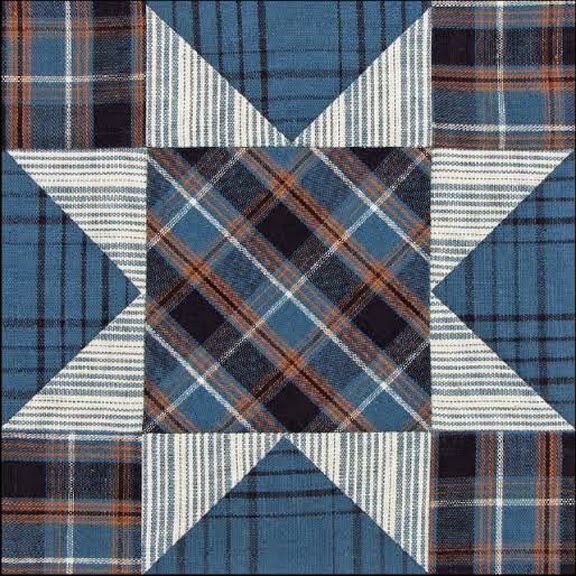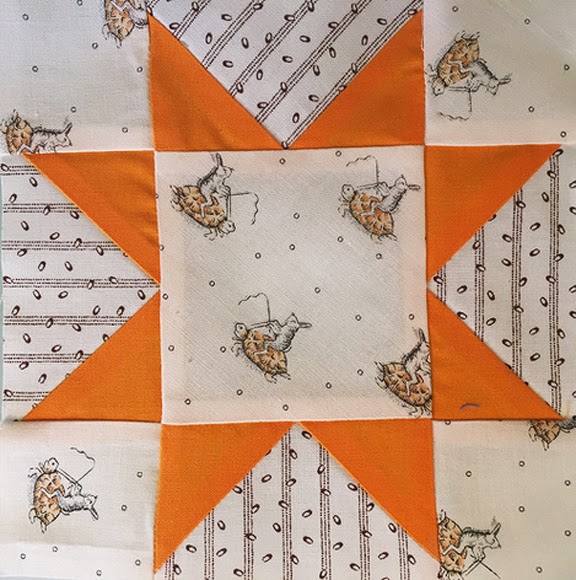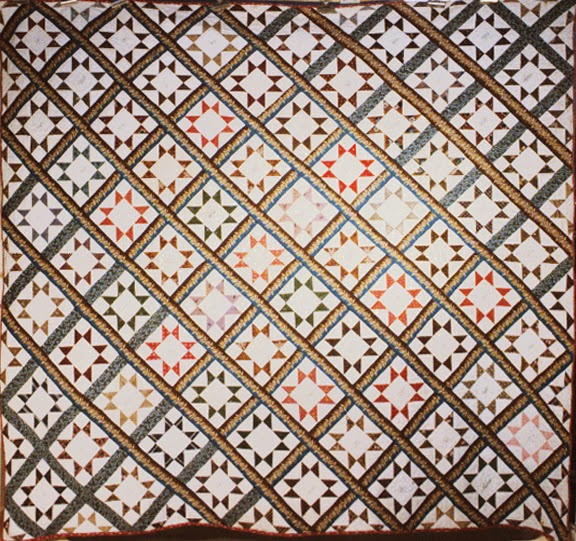Small flag quilt
Date inscribed 1862
38 1/4" by 32 1/4 "
I haven't felt completely confident about the date that is embroidered (?) on one of the flags.
1862 is inscribed in the stripe of one flag.
The overall quilt-style just doesn't look 1862. If it were not dated I would guess it was pieced between 1870 and 1890.
My dating guess is based on three style characteristics.
1) The major pattern,what might be called a charm quilt of triangles.
2) The strip border.
3) The corner treatment in the strip border.
1) The Pattern: Charm Quilt
1) The major pattern is in the style called charm quilt---a sampler of prints. This is not a true charm quilt as there are numerous duplicate prints, but very few charm quilts achieved the goal of no two prints alike.
The pattern of squares half dark and half light is common.
The small quilt above is date-inscribed 1897.
1862 Flag quilt detail
The style idea in a charm quilt is to use prints for both light and dark areas and stitch the quilt from only one shape.
This flag quilt is the earliest date-inscribed quilt in this style that I've seen. Anytime one finds a very early or a very late example---an outlier---one should be suspicious.
Quilt date-inscribed 1876
The charm style was extremely fashionable in the 1870s. Here's the next-earliest version I've seen with a date on it, pieced of Centennial Prints in 1876, the date of the U.S. Centennial celebration.
Quilt date-inscribed 1882
Small quilt date-inscribed 1883 from the
Nickols collection at San Diego's Mingei Museum.
Many quilts were made in charm style after 1870. One gets the feeling quilters were celebrating a new abundance of American prints in new styles, such as the black (brown?) lace print that is the border here. Lace prints in stripes were quite popular in the 1880s.
Quilt date-inscribed 1869, documented by the Heritage Quilt Project
of New Jersey, photo from the Quilt Index
This is the closest thing I have found dated in the 1860's and it's similar only in the use of the half-square triangle and prints for the light colored areas. The large white triangles are a solid white. It's not a charm quilt but it is pieced of half-square triangles.
2) The Border Style
The border pieced of multiple strips is also a style seen more after 1870 than before. This is not one of the strongest clues to date; thereare earlier quilts with multiple strip borders.
3) The border corner treatment.
A stronger clue to a post-Civil War date is in the way the borders turn the corners. The style is not mitered and is not even pieced to look mitered. The strips are just seamed as they were added, in a rather casual fashion typical of the late-19th and early 20th century. Today people call the style a run-on border.
See a post I wrote on this late 19th-century border corner here:
My thinking is that the crib quilt is more typical of Centennial-style quilts
Such as this quilt pieced of triangles framing a central panel printed to commemorate
the 1876 Centennial and four flags cut from another Centennial commemorative.
An undated charm quilt of rectangles featuring a flag in the collection of the New England Quilt Museum. Is it a Centennial quilt celebrating 100 years of American independence and a lot of calico?
Next week the defense for a Civil War date on the crib quilt gets an airing. (I'm doing both sides of the debate here all by myself but if you have ideas do comment, please!).




















.jpg)









.jpg)





.jpg)

































VKBRQU0bWSQ!~~60_57.jpg)









































YLBRujrVe5JQ~~60_3.jpg)








































.jpg)
.jpg)


.jpg)



































































































































zG!3g~~60_57.jpg)












.jpg)















.jpg)



















QE9s3HFf3cBRo7T(UNsQ~~60_57.jpg)




.jpg)





















































































QCGk~%24(KGrHqMH-DEEreEq4qeoBK7%2CSdVzQQ~~_3.jpg)







































